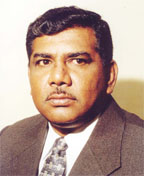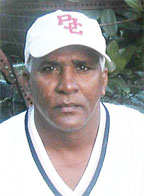Murder with malice has become a mark of present-day society
Jairam Ronald Gajraj earned the dubious distinction in Guyanese history as the minister who presided over the deadliest spate of criminal violence and the sharpest sustained surge of murder since Independence. It was during his troubled tenure of office as Minister of Home Affairs − from January 1999 when he was sworn in to May 2005 when he was forced to resign − that murder with malice became terrifyingly banal and methodical.

The two incidents that contributed most to Gajraj’s downfall were murders. The first was that of the hired killer Axel Williams, a former member of the Guyana Police Force who was also a member of a ‘death squad.’ Williams was found to have made at least 118 calls to a mobile telephone that was used by Ronald Gajraj over a twelve-day period at the height of which six unexplained murders occurred. From all that the public knows, it appears that Gajraj was in regular communication with Williams up to the time the latter was murdered on December 10, 2003.
The second was of George ‘Bumbalay’ Bacchus, another member of a ‘death squad’ who became queasy over the mounting number of murders of innocent men. He expected the worst when his brother Shafeek Bacchus was mistakenly murdered by a gang of gunmen on January 5, 2004. Shorn of witness protection, Bacchus sought safety in publicity. He confessed to being an informant for a death squad which carried out ‘numerous’ extra-judicial executions during the troubles on the East Coast of Demerara.
Bacchus talked a lot. He swore to an affidavit claiming that a senior administration official was involved in directing a ‘death squad;’ that the squad had ties to businessmen who funded its murders and that active members of the Police Force were involved in those murders. He also identified a building in Georgetown where the death squad’s victims were tortured and disclosed the locations and described the manner of disposal of the victims’ bodies. Murder, he wrote, was centrally planned and methodically executed.

The publication of Williams’s telephone record and the implications of Bacchus’s allegations ignited such a political firestorm that President Bharrat Jagdeo was obliged to appoint a Presidential Commission of Inquiry in May 2004. The Inquiry’s task was to determine whether “the Minister of Home Affairs, Mr Ronald Gajraj, has been involved in promoting, directing or otherwise engaging in activities which have involved the extra-judicial killing of persons.”
Bacchus − the likely star witness in the Inquiry − was murdered in his bed at home on June 24, 2004. This was timely as, exactly eight days later, the commissioners were sworn in on 2nd July. The Commission eventually found no evidence against the Minister largely because, expectedly after Bacchus’s exemplary execution, witnesses prudently stayed away from the Inquiry. Gajraj eventually resigned his portfolio in May 2005 but, by that time, the landslide of murders had developed a momentum that continued for the next three years.
How did murdering people become so pervasive for so long in this little country?
Two factors, more than any others, contributed to the sharp rise in these crimes. First was the traditional venality of the Police Force which should have prevented the crimes or arrested the killers. No administration has seriously attempted to stamp out extra-judicial killings and, by the time of the US Embassy’s Thomas Carroll visa fraud scandal in 2000, it was clear that well-placed members of the Police Force were being paid good money to work as ‘enforcers’ for the racketeers.

The second factor was the vitality of the drug cartels. Narco-trafficking was a lucrative business that spawned money-laundering, gun-running and graft. In the era of globalization, transnational criminal transactions were strengthening at the same time. The murders of cambio operators Neville Sarjoo and Herman Sanichar were indicators that money-laundering was rife and drug-gang warfare was already being waged.
These two factors – a weak Police Force and a strong drug cartel – contributed to making the last decade a murderous episode for people in this country. Nowadays, two or three Guyanese are killed every week in what can be categorized as state killings, domestic murders, disorderly murders, execution-murders and mass murders.
A significant source of murder − although the crime is usually referred to as ‘extra-judicial killing’ − has been at the hands of officers of the state, particularly the Guyana Police Force, Guyana Defence Force and Guyana Prison Service. Although there is no evidence that these killings are acts of state policy, it is clear that enough has not been done to investigate the crimes, punish the culprits and prevent recurrences.
It was not until the Guyana Human Rights Association published its landmark study – Ambivalent about Violence: A Report on Fatal Shooting by Police in Guyana, 1980-2001 – that the gravity of state-sponsored murder was established. The killings of suspects in ‘confrontations’ with the police and the joint services seem to have become normalised as the collateral consequences of law enforcement actions. Many of these killings remain uninvestigated to this day and are the bloody legacy of the various police special squads which have been created from time to time.
The fact is that, in the 21-year period under study, the police had managed to kill 239 persons. This was an average of over 11 persons per annum during the course of both the People’s National Congress and People’s Progressive Party administrations. The period covered by that study stopped before the East Coast troubles started and a fresh study needs to be done to bring the record up to date. The Joint Opposition Parties’ Dossier which was released last November, however, does not adequately add to the GHRA’s pioneering research.
State killings have been going on for decades but the event which fixed the public imagination and seared the act of murder in the public mind was the shooting down of an unarmed suspect – Linden ‘Blackie’ London with his arms outstretched – by the police in Eccles in February 2000. The spectacle was transmitted into Guyanese living rooms via live, prime-time, television broadcast. As exuberant policemen exchanged sportsmanlike ‘high-five’ congratulations before a curious crowd of spectators, the TV show illustrated how worthless the concepts of due process and the rule of law had become and how little value the police placed on protecting human life.
The new millennium introduced an episode of gang warfare. Most of the killings during the troubles on the East Coast and elsewhere between 2002 and 2008 were carried out by gangs. The ‘gang of five’ bandits – Shawn Brown, Anthony Dick, Andrew Douglas, Mark Fraser and Dale Moore – the chief gunmen who were held culpable for the criminal violence, had escaped from the Georgetown Prison on 23rd February. There was no discernible surge in crime for over six weeks afterwards, however.
The traditional date for the start of the troubles was April 6, 2002 when Tshaka Blair was killed in his home in Buxton by a police posse led by Senior Superintendent Stephen Merai. This event created an enabling environment for the bandits to be granted asylum in the village. They were then to turn around and hold their hosts hostage. The evidence suggests that the aggressive police behaviour had so incensed the villagers that the bandits, apart from killing and robbing many innocent persons, adopted a policy of murderous retaliation against the police. As a result, more policemen than at any other time in the 170-year history of the Police Force were murdered during the troubles in 2002-2003.
The chief gangster on the other side was Shaheed ‘Roger’ Khan. At his trial in the United States last year, he was described as controlling the cocaine trade in Guyana largely because “he was backed by a paramilitary squad that would murder, threaten, and intimidate others at Khan’s directive. Khan’s enforcers committed violent acts and murders on Khan’s orders that were directly in furtherance of Khan’s drug-trafficking conspiracy.”
Khan had been allowed to recruit into his organisation several serving or former policemen, usually from the Target Special Squad. The gangster made no attempt to conceal his activities and his connections with the authorities. He published a whole-page ‘Statement’ in the newspapers on May 12, 2006 boasting that “During the crime spree in 2002, I worked closely with the crime-fighting sections of the Guyana Police Force and provided them with assistance and information at my own expense.” The death toll tells its own tale of Khan’s ruthlessness.
As a vital part of his enforcement operations, Khan was allowed to acquire intercept equipment which enabled him to listen to the conversations and determine the locations of his intended victims. The cellular intercept equipment used by Khan had been sold to the Guyana Government.
The rising tide of trafficking in illegal narcotics and firearms by criminals like Roger Khan over the last decade brought waves of criminal violence to this country. The violent armed gangs spawned by the Mashramani prison escape in 2002 also contributed most to the high toll of murders during the troubles on the East Coast. The dozen massacres – at Campbelville at Nathoo’s bar; Lamaha Gardens; Bourda; Buxton-Friendship; Prashad Nagar; Agricola-Eccles; La Bonne Intention; Bagotstown-Eccles; Black Bush Polder; Lusignan; Bartica and Lindo Creek – indicate how commonplace multiple murders became.
There can be no certainty but the general belief is that many execution-type murders were the result of the settling of scores associated with the narco-trafficking and money-laundering business. The early executions of drug-dealer and cambio-operator Herman Sanichar and Neville Sarjoo indicated such a trend. The grisly decapitation of Farouk Kalamadeen and the recent shooting of Ramzan Ali, Thakur Persaud and others suggests that, as long as the trade continues, it will be accompanied by disputes which will be settled by murders.
Predictably, the worst effects of the surge in serious crime have been murders in the ‘big empty’ spaces of the hinterland and in the coastal and riverine waterways. The understrength Police Force is incapable of effectively enforceing the law in the huge hinterland west of the Essequibo River where bandits ambush travellers, rob and kill miners and often settle disputes with gunfire. The hinterland has become an economic zone for gold and diamond smuggling, illegal fuel smuggling, gun-running, narco-trafficking and assorted contraband and an attractive quarry for bandits.
Maritime piracy has been another source of murders. Occasional discoveries of the gutted bodies of artisanal fishermen and crew members at various locations along the coast and in the estuaries of the great rivers are reminders that murders by pirates still occur.
With the killing of Rondell ‘Fineman’ Rawlins – probably the most ruthless bandit of all time in Guyana’s history – on August 28, 2008, the grand robber-gangs have disappeared. Criminal squads seem to be smaller in size and made up of two or three young men, frequently teenagers. They enter the premises pretending to be customers, do not bother to conceal their identities by wearing masks but are invariably armed with a hand gun or two which they are prepared to use without provocation. They aim to rob, rather than kill but too often do so. With their booty, often no more than a single day’s takings, they escape unhurried in identifiable motor cars or motorcycles.
Men have been murdering their wives and partners with frightening frequency. Wife murders are not freak occurrences. The motives are varied, the brutality is intense and the scale is widespread. Domestic abuse that leads to murder is seldom sudden or spontaneous and is often predictable. In one case, a murderer was sentenced to 36 years in prison for killing both his 14-year-old partner who had ended a relationship with him and her new boyfriend in an East Coast village. In passing sentence, the judge bemoaned the facts that not only were the victims so young but that assailant had been allowed to enter a common-law relationship with a 12-year-old girl!
Largely in rural areas, also, there have been gruesome rape-murders and fatal gang-rapes sometimes of very young schoolgirls or very old women living alone. There have been murder-suicides usually of former lovers; ‘friendly’ fatal stabbings among drunken revellers in rum shops and arson or attempts at house-burning aimed at killing the occupants. In almost all of these cases, assailants seem to be familiar with their victims.
Today, human life is cheap, the consequence of the chronic failure to enforce laws which protect life or to ensure that unnatural deaths are investigated and that culprits are punished. The Police Force − the public agency that should do most to protect life − was badly compromised during the troubles. For its own part, the Force has done much to endanger the lives of persons deemed to be ‘suspects’ although some cases are not clear cut and blameworthiness is difficult to determine.
Criminal violence over the last decade contributed much to the degeneration of public perceptions of death and the value of life. Murder, however, regardless of the identities of the victims and assailants, is a matter that should be vigorously condemned and thoroughly investigated whenever it occurs. This has not been so and the actions and attitudes of the public have come to display a dangerous indifference and a drift into the dubious domain of ambivalence towards the crime.
Every person in Guyana has a right to life. Whenever the life of anyone is taken unnaturally, it becomes a public duty and a matter of public interest to determine the circumstances and causes of death. Indeed, for this purpose, every magistrate is a coroner and everyone who becomes aware of an unnatural death is required to notify it to the coroner or the nearest police station.
A member of the Police Force who becomes aware of an unnatural death is obliged to report the fact to the coroner. The coroner to whom such a death has been reported similarly is obliged to investigate the cause of death and, if necessary, to hold an inquest or inquiry. A coroner who neglects or refuses to hold an inquest or inquiry can be fined although there is no known case in which any coroner has been punished for such delinquency.
In the final analysis, the public expects the Police Force to enforce the law in a lawful manner. The criminal justice system is expected to ensure that there is full compliance with the law that requires inquests to be held to examine the circumstances surrounding unlawful killings.
Murder in Guyana has become commonplace owing as much to the criminality of bandit gangs and ‘phantom’ squads as to the incapacity of those who have failed to bring them to justice.
